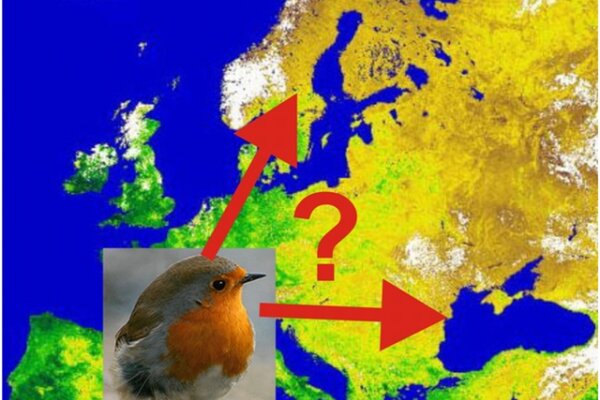2010-08-13

Migratory birds like European robins are able to use white or monochromatic light from the short-wavelength spectrum up to 565 nm to orient according to a magnetic compass system. Compass orientation is based on radical pair processes and is lateralized in favor of the right eye. For robins this implies a northbound direction towards Sweden during their spring migration. If, however, light with a long-wavelength component is given, the animals are no longer able to use their right-eye based compass system and depart to a 'fixed direction' response that is eastbound. Now a team of scientists from Frankfurt and Bochum universities demonstrated that these two visual orientation systems are differently organized with respect to hemispheric asymmetries. Robins were tested with either the right or the left eye covered or with both eyes uncovered for their orientation under different light conditions. With 502 nm turquoise light, the birds showed normal compass orientation, whereas they displayed an easterly 'fixed direction' response under a combination of 502 nm turquoise with 590 nm yellow light. Monocularly right-eyed birds with their left eye covered were oriented under turquoise in their northerly migratory direction, under turquoise-and-yellow towards east. The response of monocularly left-eyed birds differed: under turquoise light, they were disoriented, reflecting a lateralization of the magnetic compass system in favor of the right eye, whereas they continued to head eastward under turquoise-and-yellow light. Thus, 'fixed direction' responses are not lateralized. Hence und long-wavelength light the animals are no longer able to use their right-eye based compass system and depart to a non-lateralized 'fixed direction' response that is eastbound.

Migratory birds like European robins are able to use white or monochromatic light from the short-wavelength spectrum up to 565 nm to orient according to a magnetic compass system. Compass orientation is based on radical pair processes and is lateralized in favor of the right eye. For robins this implies a northbound direction towards Sweden during their spring migration. If, however, light with a long-wavelength component is given, the animals are no longer able to use their right-eye based compass system and depart to a 'fixed direction' response that is eastbound. Now a team of scientists from Frankfurt and Bochum universities demonstrated that these two visual orientation systems are differently organized with respect to hemispheric asymmetries. Robins were tested with either the right or the left eye covered or with both eyes uncovered for their orientation under different light conditions. With 502 nm turquoise light, the birds showed normal compass orientation, whereas they displayed an easterly 'fixed direction' response under a combination of 502 nm turquoise with 590 nm yellow light. Monocularly right-eyed birds with their left eye covered were oriented under turquoise in their northerly migratory direction, under turquoise-and-yellow towards east. The response of monocularly left-eyed birds differed: under turquoise light, they were disoriented, reflecting a lateralization of the magnetic compass system in favor of the right eye, whereas they continued to head eastward under turquoise-and-yellow light. Thus, 'fixed direction' responses are not lateralized. Hence und long-wavelength light the animals are no longer able to use their right-eye based compass system and depart to a non-lateralized 'fixed direction' response that is eastbound.